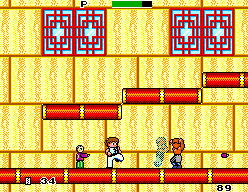- Dragon Wang
- Kung Fu Kid
If you thought Zombie apocalypse spin-offs of established franchises were a new trend, look no further than Kung Fu Kid to find your preconceptions shattered. Wang may have lost the right to appear in the title (the Japanese one translates to “Spirit World Chronicles”), but he’s still mentioned by name in the game’s description. And he bought himself a shirt.
The same formula of making one’s way through the area by kicking the endlessly respawning fodder enemies into oblivion returns, although the stages are now linear, and thanks to the graphics power of the Master System much more pleasant to look at. The level designs seem almost more primitive than in Dragon Wang, and most of them only require Wang to run from left to right, using his feet to dispose of anything that gets in his way. Some of the later stages require a bit of platforming, but even though Kung Fu Kid is one of the very first games to employ a wall jump mechanic, it’s all perfectly straight forward and devoid of any sense of exploration. Wang’s jumps at the time are extremely floaty, launching him in the air for almost the entire height of the screen, so the platforming never feels particularly challenging, either. There are a few hidden items to find, but half of them are just health refills, while others, like a potion that turn’s Wang’s hair purple, don’t seem to actually do anything useful.
Generic hoodlums are still among the attackers, but the enemy’s main forces now consist of the undead. Although most enemies fall into the greater category of “traditional Chinese zombies,” there’s a lot of variety in fighting them. There are hopping zombies (like those in Super Mario Land), tiny zombies that shoot their arms at Wang, and green zombies that can only be destroyed by magic – Wang’s feet are still his premier weapon, but to counter the hordes of the undead he also picks up charms that can then be sent flying to set everything in their way on flames (except for the bosses, who are uniformly immune to them). In some stages Wang is attacked by small enemies like lobsters(?) and frogs, and kicking them turns them into deadly projectiles for some reason.
Suitable to the game’s theme, the major opponents at the end of each level reach from wizards and flying ghosts to club-swinging ogres and all the way to giant toads. Towards the end await a few more conventional martial artists, and at two points Wang has to fight twin enemies at once. Most bosses have some blind spot he’s best advised to exploit, but it’s not enough simply to be better than them – Wang also has to balance out the handicap by the wounds he’s been dealt throughout the stage. Like in the first game, regular enemies are not very likely to actually stop him, but getting to the end with a majority of the health bar intact is very difficult. When losing a life, even during the boss fight, Wang always starts from the very beginning of the stage. This becomes increasingly painful as the player progresses through the game, especially in stage 6, which exclusively consists of a massive 5-part boss rush.
While Kung Fu Kid has the difficulty of a Castlevania or a Ninja Gaiden, it decidedly lacks the finesse and perfection rank among the truly great action platformers of its time. In the arcades, Sega’s own Shinobi and beat-em-ups like Double Dragon had all showed new directions for the genre to go in, leaving Kung Fu Kid lying in the dust like a relic of ancient times. It’s by no means a bad game; it has servable mechanics, a few unique gameplay elements, cool enemies and an interesting premise. But in the case of Kung Fu Kid, being decent was not good enough, and so it went generally overlooked and forgotten. With just a little more inspired level design, more polish and somewhat expanded length, it could have been Sega’s answer to Castlevania.
The game did get a second life in Brazil, though. It was one of the titles Tec Toy salvaged when they got hold of some profitable cartoon licenses in the mid-90s, and thus Sapo Xulé: O Mestre do Kung Fu was born. This version replaces Wang with the eponymous, terribly animated frog, but otherwise remains exactly the same game – which makes things a bit awkward when Sapo gets to fight the “normal” frogs in stage 3.

